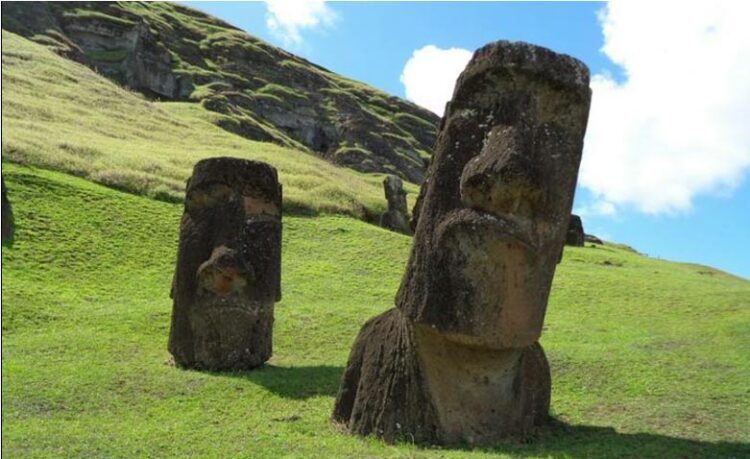Study Challenges Popular Idea That Easter Islanders Committed ‘Ecocide’
A new study is challenging the long-held belief that the ancient inhabitants of Easter Island, also known as Rapa Nui, caused their own societal collapse through environmental mismanagement. Instead, the research reveals that the islanders found ingenious ways to adapt to their harsh environment, maintaining a stable population through sophisticated agricultural techniques.
Rethinking the Ecocide Narrative
For years, the story of Rapa Nui has been one of ecological disaster. Polynesians settled the island around 1200 AD, erecting the iconic “moai” statues. According to popular accounts, such as Jared Diamond’s 2005 book Collapse, the islanders eventually overexploited their resources, leading to deforestation, soil degradation, and societal collapse. By the time Europeans arrived in 1722, only a few thousand people remained.
However, a new study published in Science Advances offers a different perspective. Led by Dylan Davis, a postdoctoral researcher at the Columbia Climate School, the research team argues that the population of Rapa Nui never reached unsustainable levels. Instead, the islanders used a technique known as lithic mulching or rock gardening to cultivate their primary food source, sweet potatoes, in a challenging environment.
Lithic Mulching: A Sustainable Agricultural Practice
Easter Island, one of the most remote inhabited places on Earth, posed significant agricultural challenges. Unlike the lush tropical islands of Hawaii and Tahiti, Rapa Nui’s volcanic soils had long since lost their nutrients. Additionally, the island’s subtropical climate and lack of productive marine habitats made food production difficult.
To overcome these obstacles, the Rapa Nui people developed rock gardens. By scattering rocks over their fields, they created microclimates that conserved moisture, moderated soil temperatures, and slowly released mineral nutrients. This technique, also used in places like New Zealand and the U.S. Southwest, allowed them to grow sweet potatoes despite the poor soil quality.
So-called rock gardens were key to feeding the population of Rapa Nui, today commonly known as Easter Island. Robert DiNapoli, coauthor of a new study on the gardens, inspects one. (Carl Lipo/Columbia Climate School)
The new study involved five years of on-the-ground surveys and the use of advanced satellite imagery to map the extent of these gardens. The researchers found that the rock gardens covered only about 188 acres, less than one half percent of the island. This area could have supported around 2,000 people if their diet was solely based on sweet potatoes. However, isotopic analysis of human remains suggests that marine sources and other crops like bananas and taro also contributed to their diet, raising the population capacity to about 3,000—consistent with the numbers observed by early European visitors.
Revisiting Population Estimates
Previous estimates of Rapa Nui’s historical population have varied widely, with some suggesting peaks of 17,500 to 25,000 people. These estimates were partly based on the assumption that the construction of the massive moai statues required large labor forces. However, the new findings indicate that the island’s population was much smaller and more stable than previously thought.
“There are natural rock outcrops all over the place that had been misidentified as rock gardens in the past,” said Davis. The use of shortwave infrared satellite imagery provided a clearer picture, highlighting areas with higher soil moisture and nitrogen—key indicators of productive gardens.
The study’s coauthors, including Carl Lipo of Binghamton University and Seth Quintus of the University of Hawaii, suggest that the new evidence paints a picture of a resilient society that adapted ingeniously to its environment. Rather than experiencing a dramatic collapse, the Rapa Nui people maintained a sustainable lifestyle through labor-intensive agricultural practices.
Today, Easter Island’s population has grown to nearly 8,000, bolstered by tourism and imports. However, some residents continue to practice traditional agriculture, particularly during periods like the Covid-19 lockdowns when imports were restricted. The study underscores the importance of sustainable practices, as modern farming techniques risk depleting the island’s already thin soil cover.
The new findings provide a valuable case study in human adaptation and resilience. Despite the severe environmental limitations, the Rapa Nui people developed innovative strategies to sustain their community for centuries. This research not only revises our understanding of Easter Island’s history but also offers broader insights into human ingenuity in the face of environmental challenges.
Source link : https://www.ancient-origins.net/news-history-archaeology-ancient-places-australia-oceania/easter-island-ecocide-0020969
Author :
Publish date : 2024-06-21 11:33:16
Copyright for syndicated content belongs to the linked Source.
